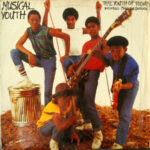 Max Headroom is a fictional character and television personality that emerged during the 1980s as part of a satirical commentary on the rapidly advancing world of technology, media, and corporate control. Created by George Stone, Annabel Jankel, and Rocky Morton, Max Headroom quickly became an icon of the era, blending science fiction with social critique. His unique look, quick wit, and futuristic persona made him a memorable part of pop culture, and his presence on TV, film, and advertising contributed to the growing trend of media parodies. Max Headroom wasn’t just a character; he was a vision of the future, reflecting society’s fears and fascination with technology.
Max Headroom is a fictional character and television personality that emerged during the 1980s as part of a satirical commentary on the rapidly advancing world of technology, media, and corporate control. Created by George Stone, Annabel Jankel, and Rocky Morton, Max Headroom quickly became an icon of the era, blending science fiction with social critique. His unique look, quick wit, and futuristic persona made him a memorable part of pop culture, and his presence on TV, film, and advertising contributed to the growing trend of media parodies. Max Headroom wasn’t just a character; he was a vision of the future, reflecting society’s fears and fascination with technology.
Origins of Max Headroom
Max Headroom first appeared in a British TV movie titled Max Headroom: 20 Minutes into the Future in 1985. The movie served as a satirical exploration of a dystopian society where television is the dominant force shaping culture and reality. The title character, Max Headroom, is an artificial intelligence (AI) created as a virtual personality by a corporation that manipulates media for profit.
The character’s creation was intended as a response to the growing power of the television industry, corporate control over entertainment, and the media’s potential to manipulate public opinion. The name “Max Headroom” was derived from the term used in television broadcast jargon, which refers to a “headroom” or space above a subject’s head that ensures proper framing in a shot. It also symbolizes the disorienting and dehumanizing nature of the media and technology, as well as Max’s disembodied, almost robotic quality.
The movie was directed by George Stone, Annabel Jankel, and Rocky Morton, who were inspired by the rise of new technologies, such as the personal computer, as well as the growing influence of television and consumerism. They wanted to craft a character who was an exaggerated representation of the media landscape—part human, part machine, and entirely consumed by the world of television.
The Character of Max Headroom
Max Headroom, portrayed by actor Matt Frewer, is a computer-generated, heavily stylized virtual host whose presence is defined by his glitchy, stuttering speech patterns and distorted image. His appearance is striking, with a jagged, blocky hairstyle, a futuristic suit, and an over-the-top persona that oscillates between being sardonic, manic, and absurdly comical. Max is a parody of the slick, polished television personalities of the time, and his character embodies the artificial, superficial nature of media.
Max’s stuttering, computerized voice became one of his most distinctive traits. His speech was slow and deliberate, with frequent pauses that seemed to mirror the malfunctioning of a machine. This bizarre way of talking was a deliberate choice to emphasize the disconnect between Max’s human appearance and his mechanical, artificial nature. Max’s bizarre mannerisms and unpredictable nature were a stark contrast to the more conventional, controlled personalities of the day, making him an instant cultural curiosity.
At his core, Max Headroom was a satirical commentary on the commodification of television. He was a corporate creation designed to sell products, but over time, he became aware of his role as an entertainment figure and, in a way, began to parody the very system that created him. Max’s consciousness, though artificial, allowed him to critique the media landscape, blurring the line between character and creator, reality and fiction.
Max Headroom and the TV Series
Following the success of the TV movie, Max Headroom made the leap to a full-fledged television series, Max Headroom, which aired on ABC in the United States from 1987 to 1988. The series took place in a near-future world dominated by corporations and media conglomerates. The show was set in a dystopian society where television was not just entertainment, but a controlling, omnipresent force in every aspect of life. The main character of the show, Edison Carter, was a hard-nosed reporter working for Zik-Zak, a powerful media corporation. After being gravely injured in an accident, Carter’s mind is uploaded into a computer, creating the virtual persona of Max Headroom.
The series was ahead of its time in exploring themes that have only become more relevant in the modern digital age. It explored the dangers of corporate control over information, media manipulation, and the potential consequences of human-machine integration. The show satirized the commodification of personalities and content, while also commenting on the growing reliance on technology in every aspect of society. Through Max, the show presented a world where the line between the real and the artificial became increasingly blurred, and where human emotions and experiences were reduced to media soundbites and slogans.
Despite its innovative ideas, Max Headroom did not achieve high ratings during its original run. However, over the years, it gained a cult following and became a symbol of 1980s pop culture. The show’s visual style, which blended cyberpunk aesthetics with postmodern irony, influenced later works in science fiction and television, from The Matrix to Black Mirror. Today, it is regarded as a pioneering work in the genre of satirical, dystopian television.
Max Headroom’s Cultural Impact
Max Headroom was much more than just a TV character—he became a cultural phenomenon. The character’s memorable image and catchphrases, including his iconic “Hello, I’m Max Headroom,” became part of the lexicon of the 1980s. His distinctive voice and stuttered speech influenced a generation of media consumers who were becoming increasingly aware of the power of television and advertising.
Max Headroom’s impact also extended beyond television. The character became a prominent figure in advertising, appearing in commercials for companies like Coca-Cola and New Coke. In these ads, Max was used to target the youth market and symbolize a sense of cutting-edge coolness. His role as a marketing tool highlighted the commercial aspects of media, turning the very concept of advertising into a parody of itself. This use of Max as a commercial mascot was both a reinforcement of the idea of media manipulation and a comment on the commercialization of pop culture.
Max’s influence also extended to the world of music. He appeared in music videos, most notably in the video for “The Future’s So Bright, I Gotta Wear Shades” by Timbuk 3. In addition, his presence in pop culture helped inspire a wave of media-centric, cyberpunk-inspired music, films, and television shows in the 1980s and 1990s. His fusion of technology, entertainment, and satire resonated with a generation concerned about the rapid pace of technological change.
Max Headroom and Media Satire
One of the defining aspects of Max Headroom was its unflinching critique of media and corporate culture. The show satirized not only the corporate control of information but also the way that media could shape perceptions of reality. The series often presented exaggerated depictions of how corporations could manipulate people, with characters constantly engaging in consumerist behaviors and pursuing fame for the sake of superficiality.
Max himself, while a corporate creation, became a kind of anti-corporate figure. He was a product of the system, but he also subverted it by becoming self-aware. The character’s existence questioned the very nature of authenticity in a world where everything could be manufactured, from personalities to ideas. Max’s constant glitching and stuttering were symbolic of the imperfections inherent in the world of media—technology could create seemingly flawless images, but the true nature of those images was often chaotic and contradictory.
The world of Max Headroom was one where people’s identities were defined by their ability to sell themselves to the public. The character’s role as a virtual media star emphasized the commodification of personality and image. His irreverence and unpredictability, as well as his refusal to be completely controlled by the corporate structures that created him, made him a symbol of resistance to the idea of media as a manipulative force.
Max Headroom’s Legacy
Though Max Headroom’s time in the spotlight was relatively brief, his legacy has endured in the decades since his debut. His influence can be seen in a variety of cultural and technological developments. In the realm of television, Max Headroom was a precursor to later shows that tackled similar themes of media and technology, including The X-Files, Black Mirror, and Mr. Robot. The character’s combination of technology, media, and social critique continues to resonate in an era where digital media is more pervasive than ever.
Max Headroom’s legacy is also felt in the world of advertising. As the first artificial television personality, Max became a symbol of the commercialization of entertainment and the increasing role of media in shaping consumer behavior. His role as a spokesperson for various products and brands pointed to the growing intersection of media, technology, and marketing, where entertainment and advertising became increasingly intertwined.
Max’s portrayal of an artificial, disembodied personality also foreshadowed the rise of AI and virtual personalities in the real world. In an age where AI chatbots, virtual influencers, and deepfake technology have become a part of everyday life, Max Headroom’s exploration of the blurred lines between reality and artificiality feels more relevant than ever. His stuttering speech and robotic mannerisms were a humorous reflection of the potential pitfalls of machine-human integration, but they also underscored the dangers of losing touch with what makes us human in a world driven by technology.
In the end, Max Headroom remains an enduring symbol of the 1980s, a time when the rapid advance of technology raised questions about the future of media, entertainment, and human identity. His message of media manipulation, corporate control, and the tension between humanity and technology continues to resonate today, making him a timeless figure in pop culture history.
This post has already been read 110 times!









